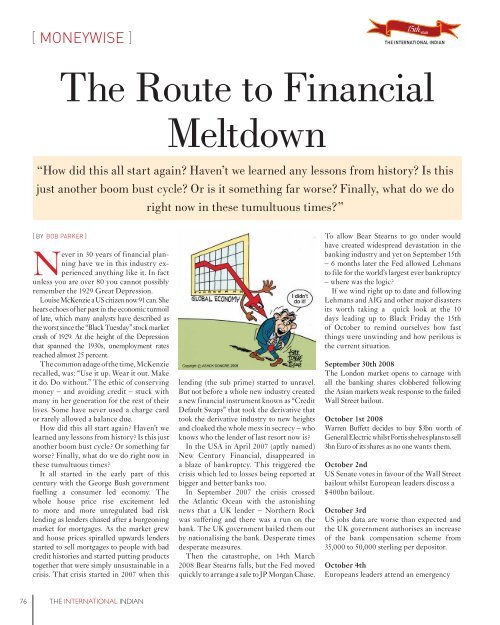THE INTERNATIONAL - International Indian
THE INTERNATIONAL - International Indian
THE INTERNATIONAL - International Indian
Create successful ePaper yourself
Turn your PDF publications into a flip-book with our unique Google optimized e-Paper software.
[ MONEYWISE ]<br />
The Route to Financial<br />
Meltdown<br />
“How did this all start again? Haven’t we learned any lessons from history? Is this<br />
just another boom bust cycle? Or is it something far worse? Finally, what do we do<br />
right now in these tumultuous times?”<br />
[ BY BOB ParkEr ]<br />
Never in 30 years of financial planning<br />
have we in this industry experienced<br />
anything like it. In fact<br />
unless you are over 80 you cannot possibly<br />
remember the 1929 Great Depression.<br />
Louise McKenzie a US citizen now 91 can. She<br />
hears echoes of her past in the economic turmoil<br />
of late, which many analysts have described as<br />
the worst since the “Black Tuesday” stock market<br />
crash of 1929. At the height of the Depression<br />
that spanned the 1930s, unemployment rates<br />
reached almost 25 percent.<br />
The common adage of the time, McKenzie<br />
recalled, was: “Use it up. Wear it out. Make<br />
it do. Do without.” The ethic of conserving<br />
money – and avoiding credit – stuck with<br />
many in her generation for the rest of their<br />
lives. Some have never used a charge card<br />
or rarely allowed a balance due.<br />
How did this all start again? Haven’t we<br />
learned any lessons from history? Is this just<br />
another boom bust cycle? Or something far<br />
worse? Finally, what do we do right now in<br />
these tumultuous times?<br />
It all started in the early part of this<br />
century with the George Bush government<br />
fuelling a consumer led economy. The<br />
whole house price rise excitement led<br />
to more and more unregulated bad risk<br />
lending as lenders chased after a burgeoning<br />
market for mortgages. As the market grew<br />
and house prices spiralled upwards lenders<br />
started to sell mortgages to people with bad<br />
credit histories and started putting products<br />
together that were simply unsustainable in a<br />
crisis. That crisis started in 2007 when this<br />
lending (the sub prime) started to unravel.<br />
But not before a whole new industry created<br />
a new financial instrument known as “Credit<br />
Default Swaps” that took the derivative that<br />
took the derivative industry to new heights<br />
and cloaked the whole mess in secrecy – who<br />
knows who the lender of last resort now is?<br />
In the USA in April 2007 (aptly named)<br />
New Century Financial, disappeared in<br />
a blaze of bankruptcy. This triggered the<br />
crisis which led to losses being reported at<br />
bigger and better banks too.<br />
In September 2007 the crisis crossed<br />
the Atlantic Ocean with the astonishing<br />
news that a UK lender – Northern Rock<br />
was suffering and there was a run on the<br />
bank. The UK government bailed them out<br />
by nationalising the bank. Desperate times<br />
desperate measures.<br />
Then the catastrophe, on 14th March<br />
2008 Bear Stearns falls, but the Fed moved<br />
quickly to arrange a sale to JP Morgan Chase.<br />
To allow Bear Stearns to go under would<br />
have created widespread devastation in the<br />
banking industry and yet on September 15th<br />
– 6 months later the Fed allowed Lehmans<br />
to file for the world’s largest ever bankruptcy<br />
– where was the logic?<br />
If we wind right up to date and following<br />
Lehmans and AIG and other major disasters<br />
its worth taking a quick look at the 10<br />
days leading up to Black Friday the 15th<br />
of October to remind ourselves how fast<br />
things were unwinding and how perilous is<br />
the current situation.<br />
September 30th 2008<br />
The London market opens to carnage with<br />
all the banking shares clobbered following<br />
the Asian markets weak response to the failed<br />
Wall Street bailout.<br />
October 1st 2008<br />
Warren Buffett decides to buy $3bn worth of<br />
General Electric whilst Fortis shelves plans to sell<br />
3bn Euro of its shares as no one wants them.<br />
October 2nd<br />
US Senate votes in favour of the Wall Street<br />
bailout whilst European leaders discuss a<br />
$400bn bailout.<br />
October 3rd<br />
US jobs data are worse than expected and<br />
the UK government authorises an increase<br />
of the bank compensation scheme from<br />
35,000 to 50,000 sterling per depositor.<br />
October 4th<br />
Europeans leaders attend an emergency<br />
76<br />
<strong>THE</strong> <strong>INTERNATIONAL</strong> INDIAN
















